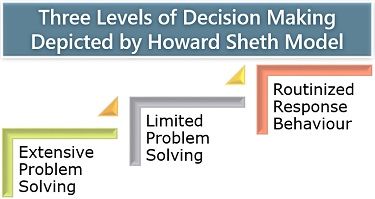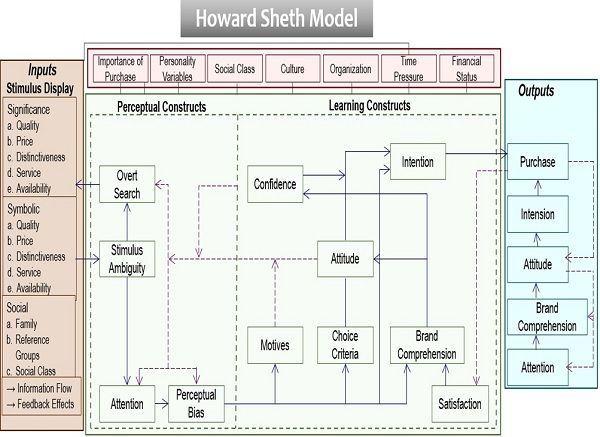Definition: The Howard Sheth Model is an approach for analyzing the combined impact of the social, psychological and marketing factors on the buying behaviour or preference of the consumers and the industrial buyers into a logical order of information processing.
John Howard and Jagadish Sheth introduced the Howard Sheth Model in the year 1969. The concept was published in their book ‘The Theory of Buyer Behaviour’.
Content: Howard Sheth Model
Three Levels of Decision-Making in Howard Sheth Model
The model has described the three significant stages of the buyer’s decision-making or selection of a particular brand. Let us now discuss each of these in details below:
Extensive Problem Solving
This is the initial stage of decision-making, where the buyer is new to the market. He/she has no or little information about the brands and has no preference for a particular product or service.
Thus, a consumer is an information seeker at this level, who check out different brands available in the market, before making a buying decision.
Limited Problem Solving
At this level, the buyer has inadequate or incomplete information about the product, market or the brands operating in it. Sometimes the buyer is confused among the various alternatives.
Therefore, to make a buying decision, he/she look for a comparative study of the different brands and the products available in the market.
Routinized Response Behaviour
The habitual response behaviour stage is where the buyer is entirely aware of the products offered by different brands and the features, pros and cons of each product.
He/she is capable of evaluating and comparing the multiple options available in the market.
Here, the buyer decides in advance, which product is to be purchased.
To understand the Howard Sheth Model, we must have an idea of its arrangement. So, let us have a look at the design of this model:
Variables of Howard Sheth Model
Beginning with the stage of extensive problem solving, the buyer slowly converts into a regular customer of the organization, at the routinized response behaviour level.
This whole process of buyer’s decision-making functions on four pillars of this model or the four essential elements of this model. These variables are elaborated below:
Input Variables
The stimulus inputs refer to the idea or information clue about the brand and its product in terms of product quality, distinctiveness, price, service offered and availability.
These can be further classified as follows:
- Significant Stimuli: The significant stimuli are the physical traits of the product and the brand. It includes the product’s price, quality, availability, distinctive characteristics and service.
- Symbolic Stimuli: The marketing strategies like advertisement and publicity creates a psychological impact on the buyer’s perception of a product’s rhetorical and visible features.
- Social Stimuli: The social stimuli comprises of the various environmental factors which are considered as a source of information for the buyers. It includes family, social class and reference groups.
Hypothetical Constructs
The hypothetical constructs depict the central part of the model. It includes all those psychological variables which play a vital role in the buyer’s decision-making process.
It can be further bifurcated into the following two categories:
Perceptual Constructs
These components define the consumer’s procurement and perception of the information provided at the input stage.
It is an essential element since it drives the buyer’s brand selection and purchases, which includes:
- Sensitivity to Information: The buyer’s level of understanding or openness towards the information received by him/her.
- Perceptual Bias: On the grounds of individual perception of each brand, the buyer is partial towards a particular brand.
- Search for Information: The buyer also seeks for more information to ensure the right decision-making.
Learning Constructs
The learning constructs define the buyer’s knowledge, opinion, attitude and end decision on product or brand selection.
Following are the various learning constructs of a buyer:
- Motive: The specific goal or purpose for which the product purchase is carried out.
- Choice Criteria: The set of principles or benchmarks defined for product selection.
- Brand Comprehension: The information about the product or brand pertained by the buyer.
- Attitude: The buyer’s perspective and willingness to purchase a product of a particular brand defines his/her attitude.
- Confidence: The trust or faith of the buyer in a specific brand and its products builds his/her confidence.
- Intention: The buyer’s purchase motive, preference criteria, brand comprehension, consumer attitude and confidence, results in the selection of a particular brand.
- Satisfaction: After-purchase, the buyer evaluates his/her level of contentment, to find out whether the product has fulfilled the expectations or not.
Output Variables
The output or as we say, the result of the buyer’s decision-making can be seen in the form of his/her response towards the input variables.
It consists of five major components which are arranged systematically below:
- Attention: The buyer’s level of concentration and alertness with which he/she understands the information provided, is termed as attention.
- Brand Comprehension: The awareness of the buyer regarding a particular brand and its products is known as brand comprehension.
- Attitude: The buyer’s evaluation of a brand in terms of individual likes and dislikes, determines his/her behaviour, interest and awareness towards it.
- Intention: The aim or objective of the buyer for purchasing a product can be seen as the buying intention.
- Purchase Behaviour: All the above elements result in the actual purchase of a product by the buyer.
Exogenous Variable
There are certain other external factors which influence the buying behaviour of an individual or a firm by hampering the product purchase of a prefered brand.
The exogenous variables are the environmental forces or components of this model. These are as follows:
- Importance of Purchase: If the buyer perceives the product to be less crucial, involving a low cost, then there is a little brand preference.
- Personality Variables: Personal traits like ego, self-esteem, anxiety, dominance, authoritarian, etc. influences a buyer’s decision-making while purchasing a product.
- Social Class: A buyer’s social group, including the family, friends and other reference groups impact the selection or rejection of a particular brand.
- Culture: The buyer’s values, beliefs and ideas frame his/her purchase motive and inhibitors.
- Organization: The buyer’s interaction with the social groups define their authority, status and power. The hypothetical constructs of a buyer are affected by such formal or informal communications.
- Time Pressure: The buyer, at times, is under the pressure of taking a timely decision, which makes him/her look for alternatives if the product of the preferred brand is unavailable at the moment.
- Financial Status: The buyer’s inability to purchase a product or unaffordability restricts him/her from buying it.
Conclusion
The Howard Sheth Model majorly emphasizes repetitive buying behaviour of the consumers or industrial buyers.
This is an empirical approach towards understanding the buyer’s mindset while purchasing a product or service. It has been intensively applied and tested to check its viability.
Still, the model lacks reliability due to its dependency on the hypothetical constructs, which are challenging to be pragmatically examined.


Leave a Reply